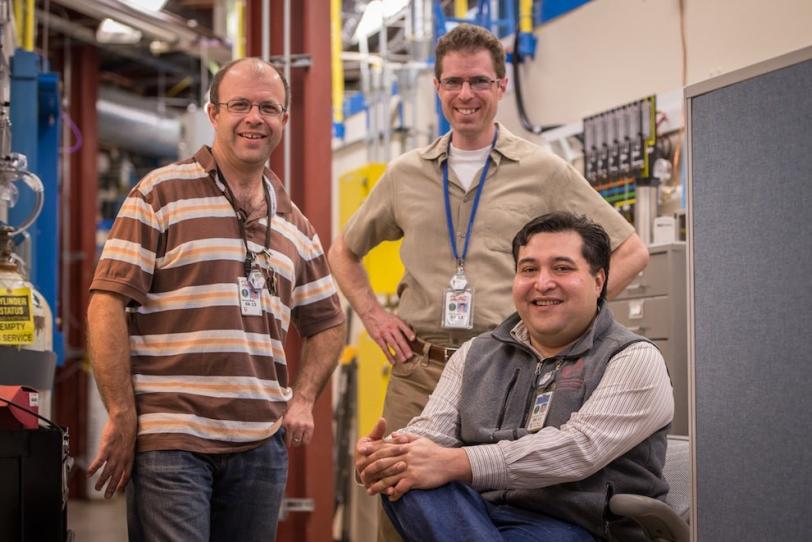Unexpected Allies Help Bacteria Clean Uranium From Groundwater
Since 2009, SLAC scientist John Bargar has led a team using synchrotron-based X-ray techniques to study bacteria that help clean uranium from groundwater in a process called bioremediation.
By Lori Ann White
Since 2009, SLAC scientist John Bargar has led a team using synchrotron-based X-ray techniques to study bacteria that help clean uranium from groundwater in a process called bioremediation. Their initial goal was to discover how the bacteria do it and determine the best way to help, but during the course of their research the team made an even more important discovery: Nature thinks bigger than that.
The researchers discovered that bacteria don’t necessarily go straight for the uranium, as was often thought to be the case. The bacteria make their own, even tinier allies – nanoparticles of a common mineral called iron sulfide. Then, working together, the bacteria and the iron sulfide grab molecules of a highly soluble form of uranium known as U(VI), or hexavalent uranium, and transform them into U(IV), a less-soluble form that's much less likely to spread through the water table. According to Barger, this newly discovered partnership may be the basis of a global geochemical process that forms deposits of uranium ore.
And it's all done using one of the most basic types of chemical reactions known: oxidation and reduction, commonly known as "redox." Redox reactions can be thought of as the transfer of electrons from donor atoms to atoms that are hungry for electrons, and they are a primary source of chemical energy for both living and non-living processes. Photosynthesis involves redox reactions, as does cell respiration. Iron oxidizes to form rust; batteries depend on redox reactions to store and release energy.
"Redox transitions are a very fundamental process," Bargar said. "It's the stuff of life. It's how you breathe."
The study, published Monday in the Proceeding of the National Academy of Sciences, was conducted at the Old Rifle site on the Colorado River, a former uranium ore processing site in the town of Rifle, Colo. The aquifer at the site is contaminated with uranium and is the focus of bioremediation field studies conducted by a larger team of scientists at Lawrence Berkeley National Laboratory and funded by the Department of Energy's Office of Biological and Environmental Research. As part of their study, the LBNL team added acetate – essentially vinegar – to the aquifer in a series of injection wells to "feed the bugs," as Bargar put it, allowing acetate to flow throughout the aquifer around the wells.
The SLAC team wanted to know what happened to the uranium during bioremediation. "We didn't want to study uranium only in the lab," Bargar said. "We wanted to understand uranium redox behavior in a living, breathing aquifer." They saw a bigger picture, including a molecular- to micron-scale view of what happened to other elements in the aquifer, such as sulfur and iron.
During a series of redox reactions, the microbes dine on the acetate, and then pass extra electrons from their vinegar meal to – among other substances – naturally occurring sulfates. This liberates sulfur from the sulfates.
A closer look at the soil, provided by X-ray microscopy images taken at the Stanford Synchrotron Radiation Lightsource and electron microscopy images recorded by collaborators at the Swiss Federal Institutes of Technology in Lausanne, Switzerland, revealed that the sulfur combined with iron in the soil to form iron sulfide nanoparticles, which did the actual work of transforming the uranium. At the same time, organic polymers produced by bacteria grabbed the transformed uranium and immobilized it. Discovering that bacteria work together with minerals to transform uranium was a surprise, said Bargar.
Bargar said the discovery that a variety of processes immobilize the uranium sheds light on previous, seemingly conflicting observations, and also explains how the process can continue even when the uranium-munching bugs are in short supply. Better understanding Nature's methods for concentrating uranium could also lead to more efficient, environmentally friendly methods for uranium mining.
But as a scientist, he appreciates the glimpse he's been given into Nature's abilities to multitask. "Originally we wanted to see what happened to uranium and how it could help bioremediation technology to be successful," he said. "But scientifically the results are much deeper than that." And since their original hypothesis focused on bacteria alone, it's a little humbling, too.
"As is usual with science," said Bargar, "you learn your original ideas were a little naive, but finding out what's really going on is very exciting."
Contact
For questions or comments, contact the SLAC Office of Communications at communications@slac.stanford.edu.






